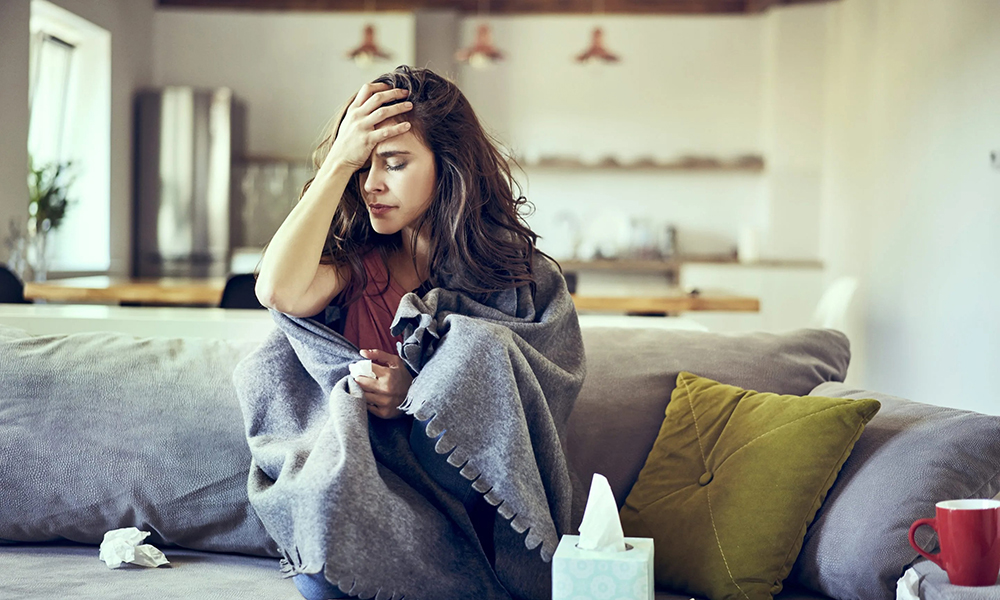
一项最新研究认为,用于治疗新冠肺炎的抗病毒药物Paxlovid并不是患者出现反弹症状的唯一原因。该研究论文今年10月发表于《美国医学会杂志-网络版》(JAMA Network)。在这项研究中,超过三分之一未服用过Paxlovid的新冠病毒感染者在初次康复两天后重新出现症状。
2020年8月至11月期间进行的该项研究,调查了150多名感染病毒后未服用过Paxlovid的患者(服用了安慰剂)。约一个月后,68%的患者完全康复,其中有44%表示在报告零症状两天后再次出现了13种常见新冠症状中的至少一种症状(例如寒颤、咳嗽、疲劳、头痛、肌肉或身体疼痛、恶心和嗓子痛等)。
绝大多数(85%)反复出现症状的患者表示症状轻微,最常见的症状是咳嗽、疲劳或头痛。有15%反复出现症状的患者称至少出现了一种中度症状。
论文作者指出:“人们报告的症状较为主观,我们观察到的变化可以解释接受新冠治疗之后某些症状反复出现的原因,比如所谓的Paxlovid反弹。”
由于症状反弹效应,即人们在康复后会再次出现症状,因此人们对于治疗新冠肺炎的抗病毒药物Paxlovid存有疑虑。
研究人员依旧在分析反弹感染现象,但许多人将其解释为人们的免疫系统尚无法充分消灭病毒。
三一健康圣玛丽医院(Trinity Health Saint Mary’s Hospital)的传染病科主任安德鲁·詹姆森博士此前曾经告诉《财富》杂志:“人体免疫系统没有机会同步产生足够多的抗体,形成持续的免疫反应。”
但专家们依旧在宣传Paxlovid降低重症或死亡风险的效果,这是这种药物的主要用途。符合条件的患者、老年人或存在重症新冠风险的患者,建议在感染病毒后的五天内服用抗病毒药物。
对于未服用Paxlovid的患者,人体的免疫反应依旧可能导致出现反弹感染,因为每个人对病毒的反应不同,甚至有患者在短暂康复一两天后病情加重。密歇根大学(The University of Michigan)的传染病医生普利提·马拉尼博士对《财富》杂志表示,老年人出现反弹感染的风险更高。
她说:“康复并非一条直线。康复情况与免疫系统对病毒的反应方式有关。”因此在首次感染后,症状可能增加也可能减少。
该项研究在新冠疫苗上市之前进行,而且当时并没有出现奥密克戎这种在各社区表现不同的新变异毒株。因此,研究结果并未考虑到人们因为接种疫苗而产生的免疫力,以及人们对不同变异毒株的反应。虽然康复后再次感染令人非常沮丧,但专家强调有些措施能够防止重症。例如,接种疫苗后出现重症、住院和死亡的风险会显著降低。(财富中文网)
译者:刘进龙
审校:汪皓
一项最新研究认为,用于治疗新冠肺炎的抗病毒药物Paxlovid并不是患者出现反弹症状的唯一原因。该研究论文今年10月发表于《美国医学会杂志-网络版》(JAMA Network)。在这项研究中,超过三分之一未服用过Paxlovid的新冠病毒感染者在初次康复两天后重新出现症状。
2020年8月至11月期间进行的该项研究,调查了150多名感染病毒后未服用过Paxlovid的患者(服用了安慰剂)。约一个月后,68%的患者完全康复,其中有44%表示在报告零症状两天后再次出现了13种常见新冠症状中的至少一种症状(例如寒颤、咳嗽、疲劳、头痛、肌肉或身体疼痛、恶心和嗓子痛等)。
绝大多数(85%)反复出现症状的患者表示症状轻微,最常见的症状是咳嗽、疲劳或头痛。有15%反复出现症状的患者称至少出现了一种中度症状。
论文作者指出:“人们报告的症状较为主观,我们观察到的变化可以解释接受新冠治疗之后某些症状反复出现的原因,比如所谓的Paxlovid反弹。”
由于症状反弹效应,即人们在康复后会再次出现症状,因此人们对于治疗新冠肺炎的抗病毒药物Paxlovid存有疑虑。
研究人员依旧在分析反弹感染现象,但许多人将其解释为人们的免疫系统尚无法充分消灭病毒。
三一健康圣玛丽医院(Trinity Health Saint Mary’s Hospital)的传染病科主任安德鲁·詹姆森博士此前曾经告诉《财富》杂志:“人体免疫系统没有机会同步产生足够多的抗体,形成持续的免疫反应。”
但专家们依旧在宣传Paxlovid降低重症或死亡风险的效果,这是这种药物的主要用途。符合条件的患者、老年人或存在重症新冠风险的患者,建议在感染病毒后的五天内服用抗病毒药物。
对于未服用Paxlovid的患者,人体的免疫反应依旧可能导致出现反弹感染,因为每个人对病毒的反应不同,甚至有患者在短暂康复一两天后病情加重。密歇根大学(The University of Michigan)的传染病医生普利提·马拉尼博士对《财富》杂志表示,老年人出现反弹感染的风险更高。
她说:“康复并非一条直线。康复情况与免疫系统对病毒的反应方式有关。”因此在首次感染后,症状可能增加也可能减少。
该项研究在新冠疫苗上市之前进行,而且当时并没有出现奥密克戎这种在各社区表现不同的新变异毒株。因此,研究结果并未考虑到人们因为接种疫苗而产生的免疫力,以及人们对不同变异毒株的反应。虽然康复后再次感染令人非常沮丧,但专家强调有些措施能够防止重症。例如,接种疫苗后出现重症、住院和死亡的风险会显著降低。(财富中文网)
译者:刘进龙
审校:汪皓
Paxlovid, the antiviral drug used to treat COVID, isn’t the only reason you could be experiencing rebound symptoms, a new study suggests. In the study, published in JAMA Network in October, over a third of those infected with COVID who didn’t take Paxlovid still experienced a recurrence of their symptoms two days after their initial recovery.
The study, conducted between August and November of 2020, looked at over 150 people who did not take Paxlovid (they were given a placebo) after contracting the virus. After about a month, 68% recovered fully, and of that group, 44% reported they had recurring symptoms of at least one of 13 common COVID symptoms after two days of reporting zero symptoms (like chills, cough, fatigue, headache, muscle or body pain, nausea and sore throat).
The overwhelming majority (85%) of people with recurring symptoms said they were mild, and most commonly reported cough, fatigue, or a headache. Fifteen percent of those with recurring symptoms reported at least one moderate symptom.
“Reported symptoms are inherently subjective, and our observed variation may explain some of the rebound of symptoms after treatment for COVID-19, like in cases of what has been described as Paxlovid rebound,” the authors write.
People have feared taking Paxlovid, the antiviral treatment for COVID, because of the reported rebound effect, where people’s symptoms come back after they recover from the illness.
Researchers are still working to understand the rebound infection phenomenon, but many explain it as people’s immune systems not being able to fully fight off the virus yet.
“Your immune system hasn’t really had a chance to catch up and really create enough antibodies to have a sustained response,” Dr. Andrew Jameson, section chief of infectious diseases at Trinity Health Saint Mary’s Hospital, previously told Fortune.
Still, experts have touted Paxlovid’s ability to curb the risk of getting severely sick or dying from the virus—its main purpose. People who are eligible, those who are older or at risk for developing severe illness from COVID, are recommended to take the antiviral within five days of contracting the virus.
And for people who don’t take Paxlovid, the body’s immune response can still make rebound infection possible—everyone responds to the virus differently, and that includes recovering briefly and getting sicker a couple days later. Older people are more at risk for these rebound infections, Dr. Preeti Malani, an infectious diseases physician at The University of Michigan, tells Fortune.
“Recovery is not a straight line,” she says. “It just has to do with how your immune system takes care of the virus,” so expect symptoms to potentially increase and decrease after initial infection.
The study was conducted prior to the rollout of COVID vaccines, as well as the emergence of new variants like Omicron that have manifested differently across communities. Therefore, the results don’t take into account people’s current immunity from vaccination nor their response to different variants. While the thought of recovering only to get sick again is more than frustrating, experts underscore that there are things that can prevent severe illness. Those vaccinated are at much less risk for severe disease, hospitalization, and death.






